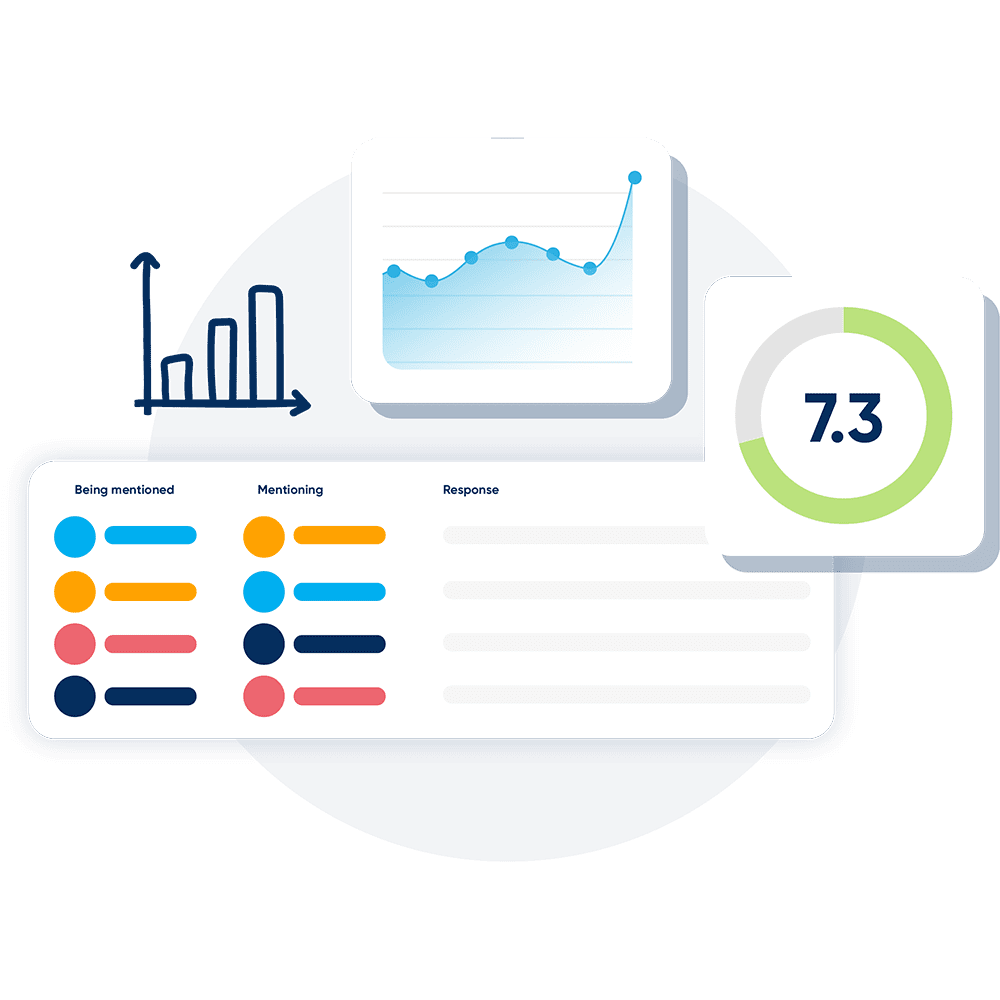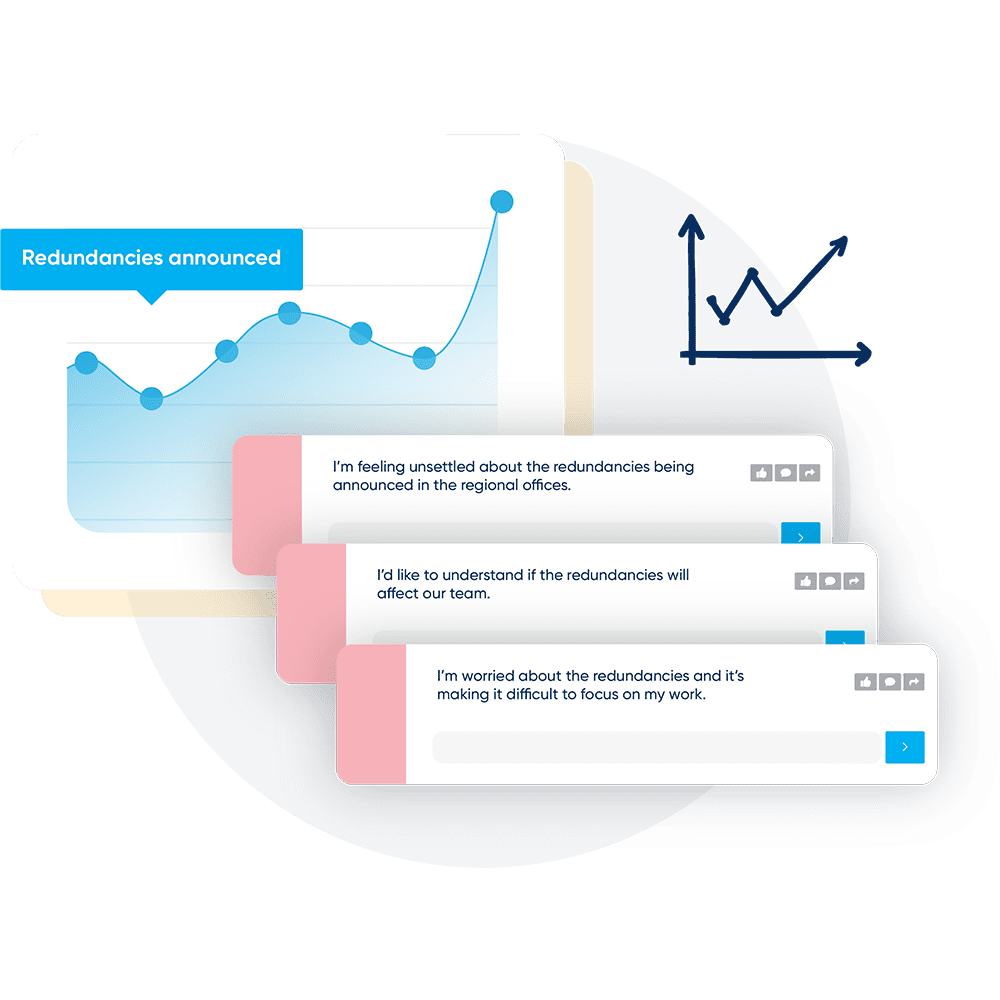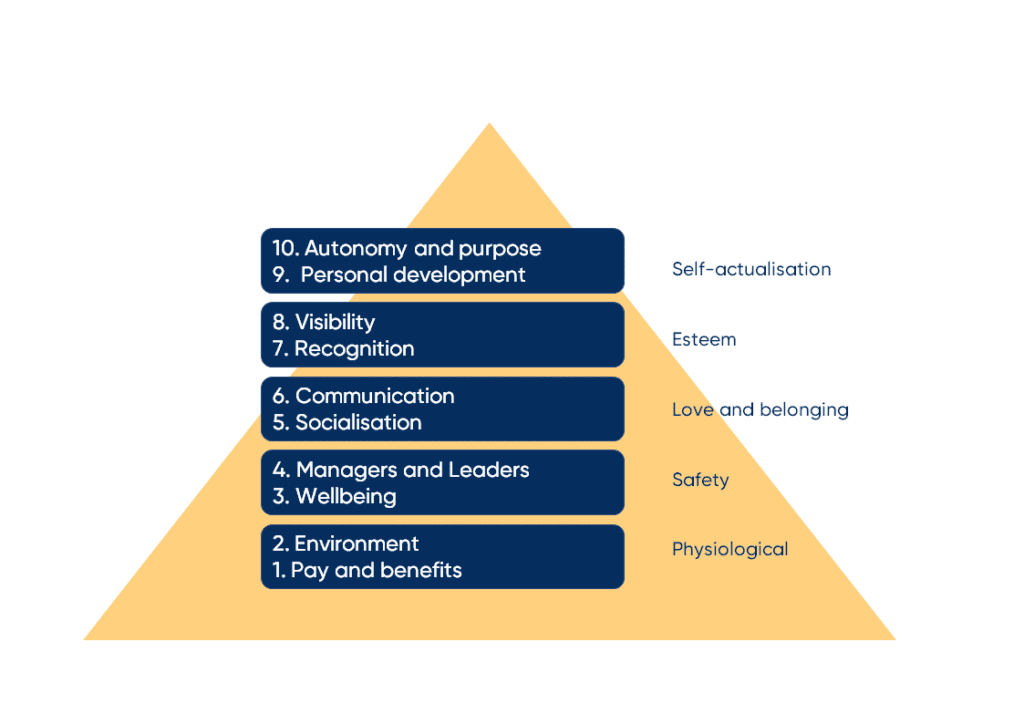It’s never been more important to connect with and understand your employees. We keep seeing terms getting thrown around, like “Great Resignation” or “talent shortage.” And these phrases have a lot of employers understandably concerned. But that’s where sentiment analysis comes in. By measuring employee sentiment, you can get to the heart of issues and create a workplace your people can thrive in.
On the whole, employees are dissatisfied. And, as employers have learned over the last year, we can’t afford to ignore it. Discontented employees have been seeking new work in droves since 2021. Now, the race is on to find a way to hang onto top talent. So, it’s fortunate that sentiment analysis can help.
Sentiment versus engagement: What’s the difference?
Let’s get our definitions clear before we jump into it. Employee sentiment and engagement are not the same thing. It’s an easy mistake to make. Sentiment is a predictor of engagement, so it’s natural to lump them in together.
Employee engagement definition
Engagement, as we’ve defined it, is the extent of someone’s commitment and attachment to their role, the business and their colleagues. Engagement is influenced by some of the above KPIs. And, in turn, it influences the others. So, for example, feeling valued may predict high engagement. And, in turn, high engagement may predict discretionary effort.
Employee sentiment definition
Sentiment, on the other hand, is the sum total of an employee’s (or a team’s) feelings about their workplace experience. In order for people to feel heard, you need to listen to individual sentiments as well as the overarching group sentiments you’re analyzing. Fortunately, a good employee check-in is all you need to look after people on the individual level. If sentiment is overwhelmingly negative, then poor engagement is almost guaranteed.
In simple terms, engagement is the end-result. Sentiment refers to the collective experiences and opinions that feed into it. So, if you don’t pay attention to the latter, you’ll never build up the former.
But what does employee sentiment analysis mean, exactly?
In essence, it’s about understanding what your people think. You take that information and study it for trends. So, it’s just like compiling survey results, right? Wrong.
While well-meaning, annual engagement surveys have a lot of flaws. They can have poor response rates, often missing your top performers. The large gaps of time between surveys can limit their insight. And, on top of that, they tend to over-rely on quantitative results that can be easily biased. Using annual survey results for sentiment analysis won’t give you the info you need.
Which is why our sentiment analysis tool works alongside our employee check-in. We’ve designed our asynchronous check-ins to handle the shortcomings of traditional employee surveys. They include plenty of qualitative, open-ended questions so people can answer in their own words. Most importantly, they run weekly. That way, feedback is real-time rather than a snapshot.
“But that’s too much sentiment to analyse, I’ll be at it all week!” we hear you cry. Not to worry, though. Nobody expects you to sift through all that data by hand. Modern sentiment analysis tools like ours are AI-assisted. So, what does that mean exactly?
Artificial Intelligence’s (AI) role in measuring employee sentiment
Artificial Intelligence at work can make people apprehensive. People envision automation taking their jobs, or computers becoming their inhuman bosses. Or they imagine overwrought tech-investment boondoggles with heavy price tags. But machine learning can benefit our working lives in all kinds of ways:
- Automating time-consuming busywork
- Personalizing the employee experience
- Collecting data more efficiently
- Identifying patterns and trends that humans may overlook
And those are just an example of the HR applications. AI can do all kinds of things, like take perform dangerous tasks, and identify health risks for a safer workplace. But, to stay on-topic, each of those bullet points applies to how AI helps with measuring employee sentiment.
AI-driven sentiment analysis tools can compile and analyse data much quicker than you’d manage doing it the old-fashioned way. And, on top of that, they can pick out insights that would be easy for human eyes to miss. Our own sentiment analysis tool compiles a bespoke report that lays out all of its insights in an accessible way. But how does an artificial intelligence understand qualitative input?
Natural Language Processing (NLP)
Natural Language Processing is the term for when a machine learning algorithm has to interpret written or spoken language. These days, the technology has a ton of applications. If you’ve ever used a search engine or voice-to-text translation, then you’ve experienced NLP systems in action.
The thing is, human language is full of idiosyncracies. English is especially guilty of this. Between homophones, double negatives, colloquialisms and the rest, it’s a lot to deal with. But that’s just the tip of the iceberg. NLP really shines at identifying how our views and experiences unconsciously inform our language. And that’s how it helps with measuring employee sentiment.
Quantitative survey questions come with certain issues. For example, imagine asking employees to rate their work environment on a 1-10 scale. Someone might rate their workplace seven out of ten, and that’s all the context you get. You’ve no idea why they knocked off those three points, or even what it is they like about their office to begin with.
And that leads onto the next problem: Subjective interpretation of rating scales. In theory, an “average” rating would be five out of ten. But a lot of people would consider that to be an outright bad score. Film and video game reviewers run into this problem a lot, where sevens and eights are the average, and anything less is a bad review.
But, by using qualitative questions you can analyse with NLP, you let people put things in their own words. So, even if someone’s being diplomatic with their criticism, sentiment analysis can pick up on their true feelings. Let’s look at an example.
How NLP can read between the lines
Say you’re evaluating the need for hybrid setups, so you’re asking people about their commutes. Employees might hesitate to be blunt for fear of getting seen as unprofessional. So, they aren’t going to say, ‘This commute is terrible, I hate getting up early and driving to work still tasting the toothpaste.’
But sentiment analysis may pick up on the fact that everyone’s talking about their commutes being long. Maybe traffic is regularly mentioned. Parents might talk about having to tend to their kids in a rush before heading out the door. All innocuous statements. But they make up a pattern that suggests people would benefit from getting to work from home at least some of the time.
It’s the same with any issue. One linguistic choice with specific connotations is a coincidence. But several makes a pattern. People might not say they hate your new open-plan office. But, if you’re getting a lot of incidental noise complaints, or people mentioning a lack of privacy, there are only so many culprits. Sentiment analysis helps you get to grips with what people think, not what they think you want to hear.


How can we use sentiment analysis in the workplace?
So, we’ve given you some basic examples of how AI tools can assist in measuring employee sentiment. Now, let’s look at some of the more involved ways sentiment analysis can help you build a better workplace.
Sentiment analysis gives employees a voice
When employers refuse to look at the big picture, it’s easy to pass off complaints as outliers and isolated incidents. But sentiment analysis reports make it much harder to stick your head in the sand. That means you’re much more likely to listen when your people speak up.
When you’re part of any group, you want your opinion to matter. So, it’s only natural that your employees want the same. People whose voices are heard display greater organisational loyalty. They’re much less likely to bail for greener pastures.
But, if you’re serious about keeping turnover down by giving your people a voice, bear one thing in mind. Once measuring employee sentiment gives you actionable insight, you have to follow through. If you don’t, people will stop engaging with your questions, regardless of how good and open-ended they are. Which leads us to our next point…
Promotes innovation at work
If we had to pick just one benefit of inviting your employees to the table, it’s how it promotes innovation. If we only draw wisdom from the same handful of sources, it becomes rigid and stale. But, by giving everyone a voice, you open yourself up to solutions you might not have considered.
Remote work, for instance, might have come from circumstance. But its enduring popularity with employees has made a lot of employers sit up and take note. And, on the individual level, job-crafting is becoming a more widely accepted practice in a lot of businesses.
As a manager or HR leader, it’s easy to assume you know best. But your employees experience the ground-level first-hand. So, in that sense, nobody knows better than them which parts of their daily grind need to change.
Understanding the metrics of employee engagement
We’ve left the most important sentiment analysis application for last: understanding what drives engagement. If you’ve been keeping up with our content, then you know there are five metrics for measuring engagement:
- Pride in your work
- Feeling valued by your employer and co-workers
- Willingness to give discretionary effort
- Advocating for the business
- Taking satisfaction in your work
By asking the right questions and studying the language people respond with, you can get an idea of how these KPIs are doing. For example, if someone is proud of and satisfied with their work, it’s going to reflect in the kind of answers they give you.
These metrics are best-used in conjunction with our bespoke sentiment analysis reports. By analysing trends, you can easily get an idea of how you’re doing in these areas and what exactly needs improving.











